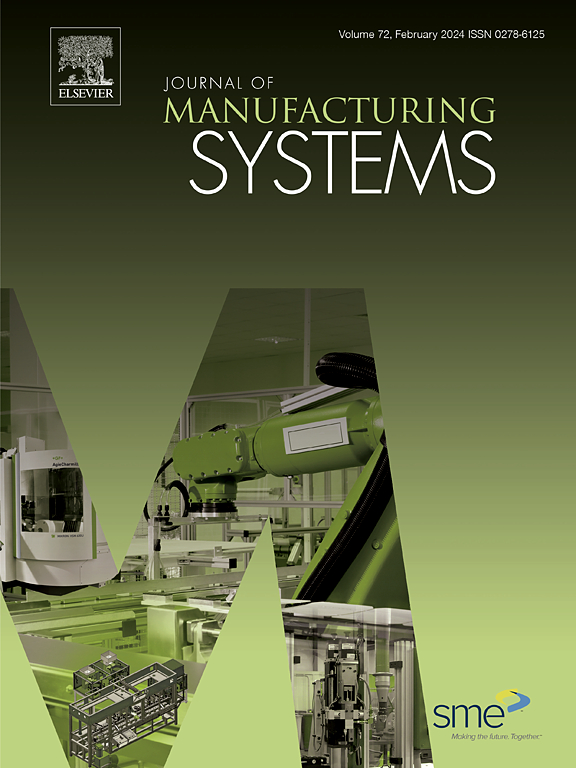利用数字孪生体进行机床热误差补偿的传感器安置
IF 12.2
1区 工程技术
Q1 ENGINEERING, INDUSTRIAL
引用次数: 0
摘要
机床的热误差会显著影响精度,从而影响生产率。减轻这些错误通常需要在能源效率和准确性之间进行权衡。虽然数据驱动的补偿模型有望解决这一挑战并实现可持续的精度,但其有效性取决于作为模型输入的传感器的仔细选择和放置。本文介绍了一种用于热误差补偿的新型温度传感器定位方法,该方法利用数字孪生框架虚拟地确定传感器的理想位置及其对补偿模型的影响。通过准确识别温度敏感点,我们的方法提高了补偿精度,减少了所需传感器的数量,从而提高了模型的鲁棒性和运行效率。为了选择这一集,不仅使用了一个模拟模型,而且使用了一个具有不同边界条件和模型性质的集合。验证结果表明,该方法优于传统的手动确定传感器放置策略,为精密制造中适应性强、节能的热管理提供了可扩展的解决方案。基于混合奇异值分解和最小绝对收缩和选择算子方法选择的传感器集仅使用7个而不是手动选择的22个温度传感器产生更强大的补偿。使用模拟数据的热误差减少范围为77%-94%,在物理机器上实现的相应减少为75%-85%。本文章由计算机程序翻译,如有差异,请以英文原文为准。

Sensor placement utilizing a digital twin for thermal error compensation of machine tools
Thermal errors in machine tools significantly impact precision and, therefore, productivity. Mitigating these errors often results in a trade-off between energy efficiency and accuracy. While data-driven compensation models show promise in addressing this challenge and achieving sustainable precision, their effectiveness hinges on the careful selection and placement of sensors as model inputs. This paper introduces a novel temperature sensor positioning method for thermal error compensation that leverages a digital twin framework to virtually determine ideal sensor positions and their effects on the compensation model. By accurately identifying temperature-sensitive points, our approach improves compensation accuracy and reduces the number of sensors required, thus enhancing both model robustness and operational efficiency. For choosing this set not only one simulation model is used but an ensemble with varying boundary conditions and thus model properties. Validation results show that the proposed method outperforms traditional, manually determined sensor placement strategies, providing a scalable solution for adaptable, energy-efficient thermal management in precision manufacturing. The selected sensor set based on a hybrid singular value decomposition and Least Absolute Shrinkage and Selection Operator approach yields a more robust compensation using only 7 instead of the manually chosen 22 temperature sensors. The thermal error reduction ranges from 77%–94% using simulated data with a corresponding reduction of 75%–85% achieved on the physical machine.
求助全文
通过发布文献求助,成功后即可免费获取论文全文。
去求助
来源期刊

Journal of Manufacturing Systems
工程技术-工程:工业
CiteScore
23.30
自引率
13.20%
发文量
216
审稿时长
25 days
期刊介绍:
The Journal of Manufacturing Systems is dedicated to showcasing cutting-edge fundamental and applied research in manufacturing at the systems level. Encompassing products, equipment, people, information, control, and support functions, manufacturing systems play a pivotal role in the economical and competitive development, production, delivery, and total lifecycle of products, meeting market and societal needs.
With a commitment to publishing archival scholarly literature, the journal strives to advance the state of the art in manufacturing systems and foster innovation in crafting efficient, robust, and sustainable manufacturing systems. The focus extends from equipment-level considerations to the broader scope of the extended enterprise. The Journal welcomes research addressing challenges across various scales, including nano, micro, and macro-scale manufacturing, and spanning diverse sectors such as aerospace, automotive, energy, and medical device manufacturing.
 求助内容:
求助内容: 应助结果提醒方式:
应助结果提醒方式:


